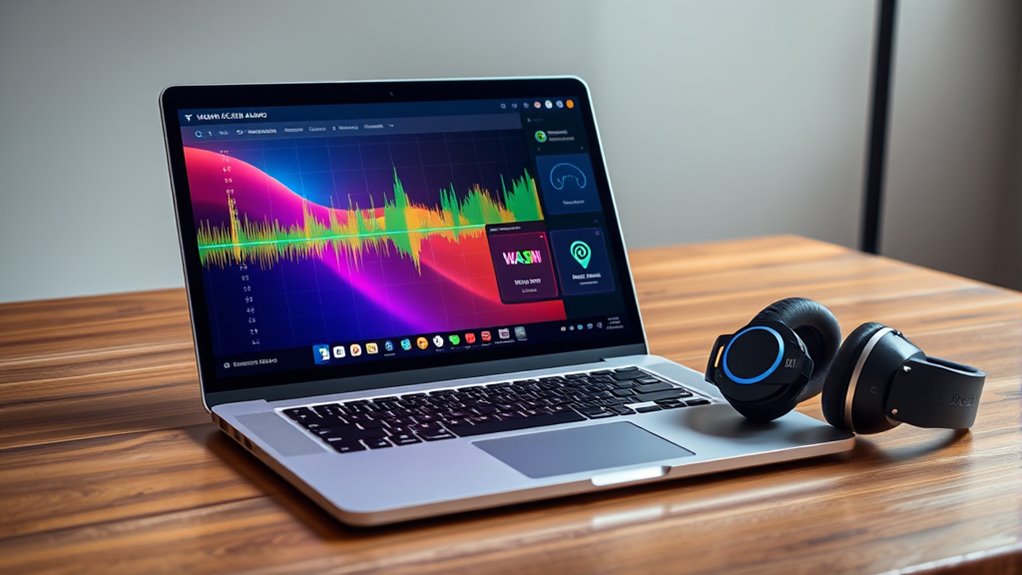With WebNN and WebAssembly (WASM), you can now process and synthesize audio directly in your browser. These technologies enable real-time neural audio manipulation without requiring external software, providing fast, high-quality sound modification, voice cloning, and live effects. WebNN accelerates neural computations, while WASM guarantees smooth, efficient performance. As a result, you get instant, interactive audio experiences. Keep exploring to discover how these tools can transform your sound projects and creative potential.
Key Takeaways
- WebNN accelerates neural network computations for real-time audio processing in browsers, reducing latency and enhancing performance.
- WebAssembly (WASM) enables high-performance, portable execution of neural synthesis algorithms directly within the browser environment.
- Combining WebNN and WASM allows complex AI-driven sound generation, transformation, and voice modulation without external software.
- These technologies facilitate live, interactive audio effects and editing, making advanced sound manipulation accessible online.
- The integration of WebNN and WASM paves the way for innovative, high-quality browser-based audio AI applications and creative tools.

Audio AI in the browser is transforming how you interact with sound by enabling powerful, real-time audio processing without needing specialized software. This shift leverages advancements like WebNN and WebAssembly (WASM), making it possible to perform complex tasks directly within your web browser. One of the most exciting aspects is neural synthesis, which allows AI models to generate or modify audio with impressive fidelity. Whether you’re creating music, enhancing voice quality, or synthesizing sound effects, neural synthesis provides a flexible, efficient way to produce high-quality audio in real-time.
With these tools, you’re no longer limited to pre-recorded sounds or relying on external applications. Instead, neural synthesis algorithms run directly in your browser, harnessing the power of WebNN, the emerging web standard for neural network acceleration. WebNN enables browsers to access hardware acceleration for neural processing, markedly boosting performance. When paired with WASM, which compiles high-performance code into a portable format, you get a seamless environment for real-time processing. This means your audio applications can perform complex neural synthesis tasks, such as voice cloning or sound transformation, with minimal latency.
The ability to process audio in real-time is vital for interactive applications. Imagine live voice modulation, instant sound effects, or on-the-fly audio editing—all happening instantly within your browser. Thanks to WebAssembly, heavy computations are executed efficiently, reducing delays and ensuring smooth user experiences. You don’t need to worry about lag or stuttering, as these technologies optimize processing speed without sacrificing quality.
Furthermore, this setup opens doors for developers and creators to build accessible, browser-based audio tools that were once only feasible with specialized software. You can experiment with neural synthesis models directly on websites, testing new ideas or deploying innovative sound applications without installing anything extra. This democratizes audio AI, making advanced sound processing more accessible to everyone.
In essence, the combination of WebNN, WASM, and neural synthesis is pioneering a new era of real-time audio processing in the browser. It empowers you to produce, modify, and interact with sound instantly and intuitively. As these technologies continue to evolve, expect even more sophisticated, responsive, and creative audio experiences—all reachable through your browser. This integration removes barriers, letting you harness the full potential of AI-driven audio directly in your web environment. Additionally, understanding the underlying sound healing science can inspire new ways to incorporate calming soundscapes into your projects for enhanced relaxation and well-being.
Frequently Asked Questions
How Does Webnn Compare to Traditional Audio Processing Libraries?
WebNN offers greater model flexibility compared to traditional audio processing libraries, allowing you to run complex neural networks directly in the browser. You’ll find it easier to integrate WebNN into web apps, but you may face some integration challenges, such as browser compatibility and performance optimization. Overall, WebNN enables more advanced AI features in-browser, while traditional libraries focus on established signal processing methods.
Are There Security Concerns With Running AI Models in the Browser?
You should know that running AI models in the browser raises some security concerns. About 60% of users worry about data privacy, and malicious exploits could target vulnerabilities in browser-based AI. While WebAssembly and WebNN add layers of security, they can still be exploited if not properly secured. Always guarantee your implementations follow best practices to protect user data and prevent malicious attacks.
What Are the Best Practices for Optimizing WASM Performance?
To optimize WASM performance, focus on efficient memory management by minimizing allocations and using shared buffers. Leverage parallel processing by utilizing Web Workers or SIMD where possible, allowing multiple tasks to run concurrently. Also, keep your code lean, avoid unnecessary computations, and test regularly across browsers. These practices help guarantee smooth execution, faster load times, and better overall performance for your web-based AI models.
Can Audio AI Handle Real-Time Noise Cancellation Effectively?
Can your audio AI handle real-time noise cancellation effectively? Absolutely, if you focus on noise suppression techniques and latency reduction strategies. By optimizing your models for quick processing, you guarantee minimal delay, making noise cancellation seamless. Efficient WebAssembly implementations can boost performance, enabling your system to filter out background noise without lag. With the right approach, real-time noise suppression becomes a practical, reliable feature for enhanced audio clarity.
How Accessible Are Browser-Based Audio AI Solutions for Developers?
Browser-based audio AI solutions are increasingly accessible for developers, thanks to growing support for WebNN and WASM. You’ll find that developer adoption is rising as these tools enable cross-browser compatibility, making it easier to build and deploy audio AI applications that work seamlessly across different platforms. While some challenges remain, such as optimizing performance, the overall landscape is becoming more developer-friendly, encouraging innovation and wider implementation.
Conclusion
With WebNN and WebAssembly, you’re opening a gateway where audio AI becomes a symphony played directly in your browser. Think of it as having a concert hall inside your device—powerful, accessible, and seamless. As these technologies evolve, you’ll find yourself orchestrating complex audio tasks without leaving your browser, turning your device into a vibrant studio. Embrace this revolution, and let your web browser be the conductor of your audio innovations.










